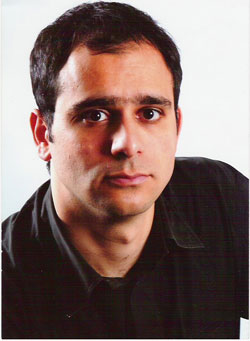New World Percussion Consort navigates mostly fluently in “Body Language” program

Vassos Nicolaou's "Navigate" had its U.S. premiere Friday night presented by the New World Percussion Consort.
Conductor Michael Linville offered a visionary, uncompromising program titled “Body Language” with the New World Symphony Percussion Consort Friday night at New World Center. As associate dean and director of chamber music activities for NWS, Linville eschewed light crowd-pleasers in favor of works of real substance, and the lineup was commendable for introducing this music to local audiences, and for offering the musicians this type of cutting-edge performance experience.
The most ambitious work on the program was the opener, Vassos Nicolaou’s Navigate. Written in 2009 for Ensemble Intercontemporain, the work presents a loud, intricate, complex texture in which each musician is tested, creating a wall of sound from which individual colors constantly emerged. Deepening the palette were live electronics diffused through a series of speakers placed throughout the hall, which swirled around the audience and heightened the overwhelming effect. Additionally, each of the 17 musicians in the chamber orchestra was amplified, emphasizing noise and overtones.
Built from timbre rather than melody or rhythm, the opening was a darkly mysterious, fascinating cacophony. This chaos gradually coalesced into slowly alternating low and high harmonic clusters based on the shifting sands of Sahara dunes. Following an extended passage of shimmering high notes, the piece exploded into the third section, no less noisy than the first but marked by much faster rhythms, as though the work was reprised on fast-forward. The Percussion Consort delivered a bravura performance.
Less successful was Morton Feldman’s For Frank O’Hara from 1973. Written for ensemble of flute (doubling piccolo and alto flute), clarinet, violin, cello and piano with two percussionists, the work is at the opposite end of the spectrum from Navigate, but no less demanding on the performers and the listener. Feldman’s timeless, non-directional music consists of discrete, quiet sonorities sustained like breaths and separated by silence. In this transparency, every note and color combination is vital to create shimmering attacks and decays. While the piece began well, the central section was marred by a number of uncoordinated entrances in the percussion, flute, and piano which shattered the spell.
The percussionists and pianist redeemed themselves in Luc Ferrari’s busy, post-modern Sexolidad for chamber orchestra from 1982-83, also heard in its U.S. premiere. Inspired by sensuality, the movements are each named for body parts. Clyde Scott’s accompanying video underlined the physicality, featuring hyper-colored, accessibly abstracted objects with sexual overtones such as crumpled paper, flowers, and condensation-covered bottles. Ironically, the music was less sexual, partly because of Ferrari’s preference for static harmonies which stalled the piece occasionally. “The Eyes” introduced two of the three main elements of the work: mildly exotic scalar runs over repeated chords while “The Hands” introduced a throbbing pulse. The best movement, “Sight,” had the musicians on fire with running sixteenth notes and a deconstructed Latin feel, like a motor missing a gear. “The Mouth” and “The Tongue” offer a heavy, static bass, recalling heavy-metal power chords, abruptly stopped the momentum, and a final gong hit was just silly. The final two movements, “The Sexes” and “The Ears,” resumed the brighter textures of previous movements, with the pleasant addition of pealing bells.
Posted in Performances
Leave a Comment
Sat Mar 10, 2012
at 2:02 pm
No Comments






